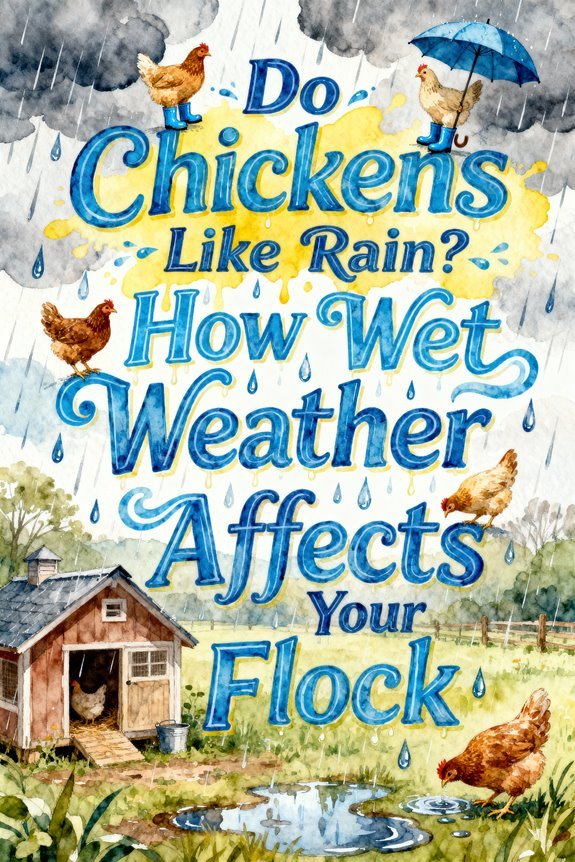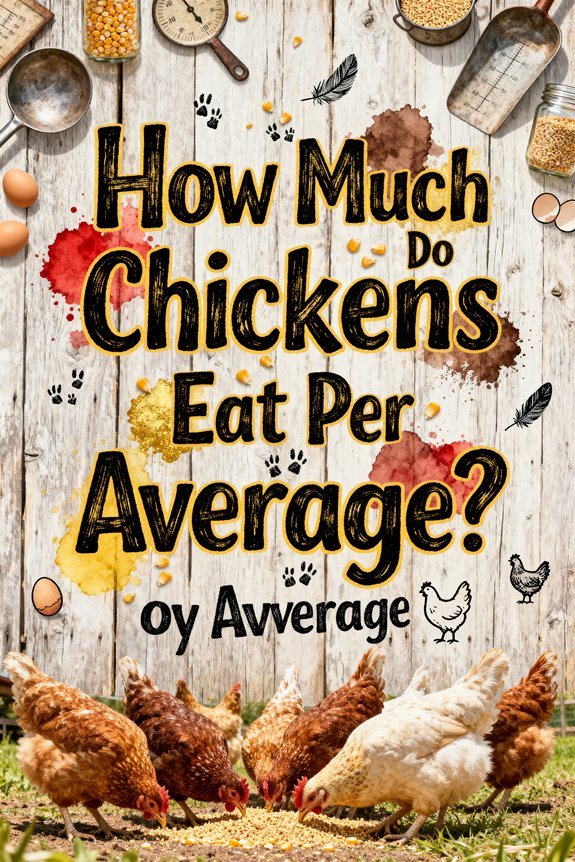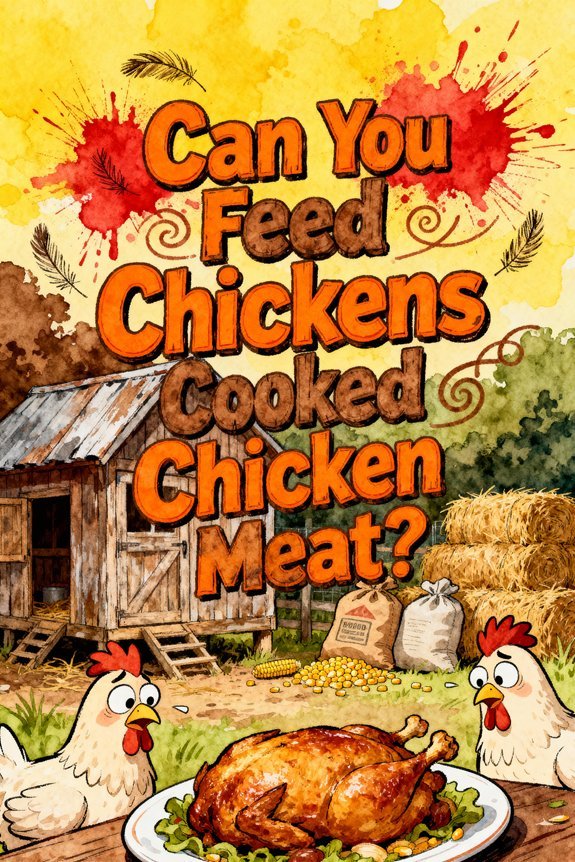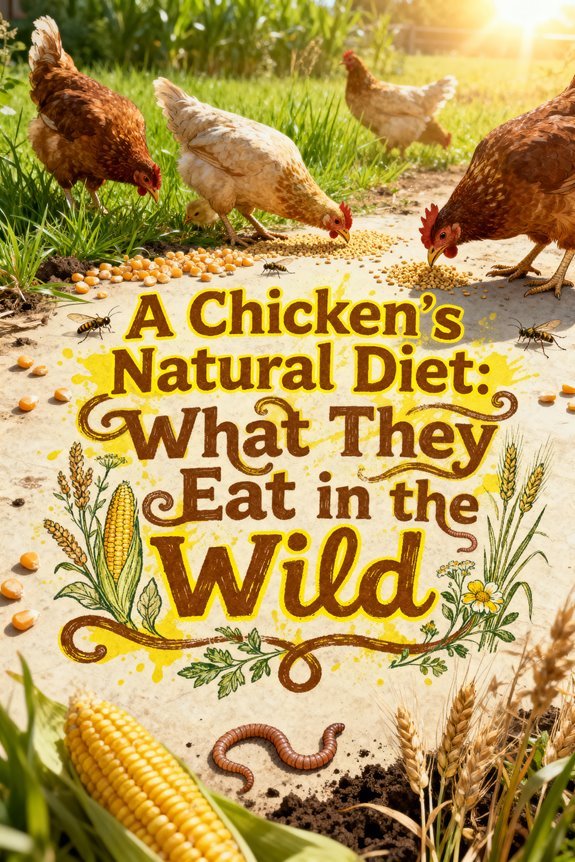Can Chickens Safely Eat Cucumbers as Part of Their Diet?
Yes, you can safely feed cucumbers to your chickens as a nutritious treat. These vegetables provide excellent hydration with their 96% water content and contain essential vitamins C, K, and A, plus minerals like manganese and potassium. To serve them safely, wash thoroughly and cut lengthwise, limiting treats to 10% of their total diet. Cucumbers are especially beneficial during warm weather for heat management, though there’s more to take into account for ideal feeding practices.
The Benefits of Feeding Cucumbers to Your Chickens
While many backyard chicken owners focus primarily on commercial feed, incorporating cucumbers into your flock’s diet can provide substantial health benefits. Cucumber varieties offer exceptional hydration support, containing 96% water, which helps your chickens combat heat stress and maintain peak metabolic function, particularly during summer months. As part of a balanced diet, cucumbers should make up 10-20% of calories along with other produce items.
You’ll find that cucumbers deliver essential nutrients including vitamins C, K, and A, along with minerals like manganese, magnesium, and potassium. These nutrients support your chickens’ immune function, bone health, and reproductive capabilities. The cucumber’s natural compounds, particularly cucurbitacin in seeds, may provide anti-inflammatory and anti-parasitic benefits. Chicken preferences typically favor raw cucumber slices, which preserve maximum nutritional value while encouraging natural pecking behaviors and reducing flock boredom. Clean peels intact can be safely included when feeding cucumbers to chickens, provided they are properly washed to remove any pesticide residue.
Understanding Cucumber Nutrition for Poultry Health
A thorough understanding of cucumber nutrition reveals specific mechanisms through which these vegetables support poultry health. Nutritional analysis shows cucumbers are 95% water, providing essential hydration, while containing just 15 kcal per 100 grams. They’re rich in key vitamins and minerals, particularly vitamin C (2.8mg/100g), vitamin K, and manganese, which support immune function and metabolic processes. The presence of vitamin A compounds helps chickens maintain optimal vision in low-light conditions.
All cucumber varieties offer beneficial phytochemicals, including cucurbitacin, which may influence gut health through microbiota modulation. Studies indicate cucumber supplementation increases beneficial Bacillus species in the poultry digestive tract. While protein content is modest at 0.7g/100g, cucumbers contribute to overall health through their fiber content (0.5g/100g) and electrolyte balance. The combination of minerals, vitamins, and bioactive compounds makes cucumbers a valuable supplemental feed, though they shouldn’t exceed 5% of total dietary intake.
How to Safely Feed Cucumbers to Your Flock
Safe and effective cucumber feeding requires careful preparation and portioning to maximize nutritional benefits while avoiding potential risks to your flock. When implementing proper cucumber preparation, thoroughly wash the vegetables under cold water to remove pesticides, especially for store-bought produce. You’ll want to cut cucumbers lengthwise and place them cut-side up for easy access, or string them on ropes to encourage prolonged feeding engagement.
For ideal feeding frequency, offer cucumbers as treats rather than primary nutrition. You can provide small daily portions during hot weather to support hydration, but don’t exceed 10% of their total diet when combined with other treats. Consider peeling cucumbers if skins appear tough or potentially contaminated with chemicals. Always monitor your birds while they’re consuming cucumber pieces to prevent choking hazards. The cucumber’s worm-controlling properties can help maintain your flock’s health when seeds are included in their treats.
Cucumber’s Role in Summer Heat Management
Managing summer heat presents unique challenges for chicken owners, and cucumbers serve as a beneficial tool in your heat-stress prevention arsenal. With over 90% water content, cucumbers provide essential hydration support for your flock when temperatures exceed 26°C. Since chickens can’t sweat, they rely on panting and wing spreading to cool down, making summer cooling strategies imperative for their well-being.
You’ll find cucumber hydration particularly advantageous because it complements your birds’ natural cooling mechanisms while delivering crucial nutrients like potassium, vitamins C and A, and magnesium. To maximize effectiveness, offer frozen cucumber pieces as treats, limiting them to 10% of total dietary intake. When combined with shade and fresh water, this cooling supplement helps maintain your flock’s core temperature and supports continued egg production during heat waves. Regular monitoring and observation of your chickens’ behavior helps detect early signs of heat stress, ensuring timely intervention with cooling treats like cucumbers. A well-designed Dutch-style barn can provide additional ventilation and shade to help regulate your chickens’ body temperature during hot summer days. While predatory birds pose risks to outdoor chickens during summer months, providing cucumber treats in covered feeding areas ensures safer consumption.
Best Practices for Serving Cucumbers to Chickens
Proper preparation and serving methods guarantee your chickens receive maximum nutritional benefits from cucumber treats while maintaining coop hygiene and flock health.
When implementing superior serving techniques, thoroughly wash cucumbers under cold water to remove pesticides and contaminants. You’ll want to peel the skin for added safety, though it’s not mandatory if properly cleaned. Cut the cucumbers lengthwise and position them cut-side up to facilitate easy pecking. For enhanced enrichment, consider stringing peeled cucumbers or offering them whole for sustained engagement. Adding a small amount of grated cheese alongside can provide extra protein enrichment.
Serve cucumbers raw to preserve hydration and nutrients, and avoid cooking them as this degrades their nutritional value. Place the treats outside the coop to prevent pest attraction, and promptly remove any uneaten portions to maintain a clean environment.
Comparing Cucumbers to Other Chicken Treats
When evaluating chicken treats, cucumbers stand out against alternatives like cabbage, pears, squash, and bread due to their exceptional hydration benefits and safety profile. Unlike treat alternatives that require careful portioning, you can’t easily overfeed cucumbers to your flock due to their low caloric content and 95% water composition. Chickens can benefit from all cucumber parts since both the flesh and peels are completely safe to consume. Heritage breed chickens, such as Barred Rocks, maintain steady egg production throughout the year and can benefit from consistent access to hydrating treats like cucumbers.
While cabbage and squash offer valuable nutrients, and pears provide antioxidants, you’ll need to moderate these treats more carefully. When creating cucumber recipes for your chickens, you don’t need to worry about removing seeds or limiting quantities, unlike pears which require seed removal due to cyanide content. Unlike black oil sunflower seeds which require portion control due to high fat content, bread, though commonly offered, provides minimal nutritional value and shouldn’t replace nutrient-dense options like cucumbers, which support both hydration and digestive health while delivering essential vitamins and minerals.
Signs Your Chickens Enjoy Eating Cucumbers
While evaluating different treats helps inform your feeding choices, observing your chickens’ behavior provides clear evidence of their cucumber preferences. You’ll notice strong feeding indicators when your birds actively peck at and chase cucumber pieces, showing immediate interest and engagement. Their content clucking and alert posture during consumption signal enjoyment, while selective eating of the flesh before seeds demonstrates clear preferences for specific parts.
Watch for signs of positive physiological responses, including normal droppings and improved hydration in warm weather. Your chickens’ enthusiastic return visits to cucumber offerings and increased activity when treats arrive confirm their appreciation. The playful interaction with cucumber peels and social sharing behaviors among flock members further validate that cucumbers serve as both a nutritious and enriching treat option. Remember that less than 5% of your chickens’ daily diet should consist of cucumber treats to maintain proper nutrition.
Maintaining Balance With Cucumber Treats
Maintaining a balanced diet requires careful consideration when incorporating cucumbers into your chickens’ feeding routine. To guarantee peak health, you’ll need to practice cucumber moderation and monitor treat frequency carefully. While cucumbers provide valuable nutrients like potassium, vitamin C, and fiber, they shouldn’t replace your birds’ primary feed. Just as Lebanese cucumbers can be thinly sliced for human consumption, the same preparation method works well for chickens.
Watch for signs of dietary imbalance, such as changes in egg production or digestive issues. You’ll want to adjust treat frequency based on your flock’s health status and seasonal needs. During hot weather, cucumbers can serve as a hydration aid, but don’t rely on them as the sole water source. Clean feeding areas regularly and remove uneaten portions promptly to maintain hygiene. Remember to introduce cucumbers gradually and balance them with other nutrient-rich foods to meet your chickens’ daily nutritional requirements.
Year-Round Cucumber Feeding Guidelines
Although cucumbers peak during summer months, you can safely feed them to your chickens throughout the year by following proper guidelines. During warmer seasons, you’ll want to offer fresh cucumber varieties daily to support hydration, while reducing portions in colder months when your flock needs more calorie-dense foods. You can maintain year-round feeding by using frozen cucumber slices in off-seasons, thawing them before serving. Like fresh lettuce, cucumbers should be served raw to preserve their nutritional benefits.
Keep seasonal feeding balanced by limiting cucumber treats to 5% of total feed intake. Monitor your flock’s response when introducing cucumbers and adjust portions accordingly. Remove large seeds to prevent digestive issues, and serve the vegetables raw, sliced, or chopped. Similar to bell peppers and asparagus, cucumbers can be served whole without removing stems or leaves. For ideal nutrition, combine cucumbers with other vegetable scraps while maintaining their primary pelleted feed as the main dietary source.



